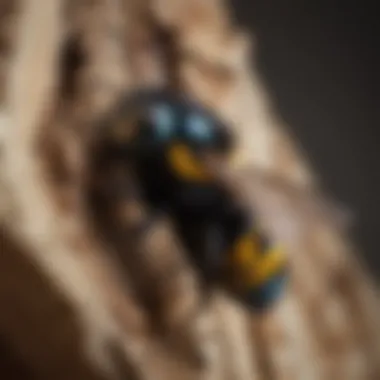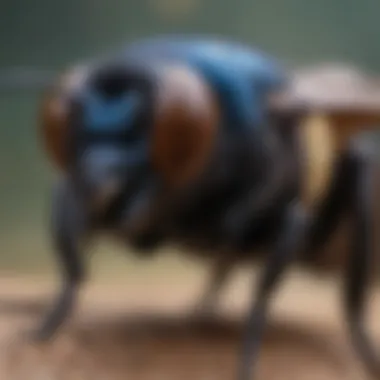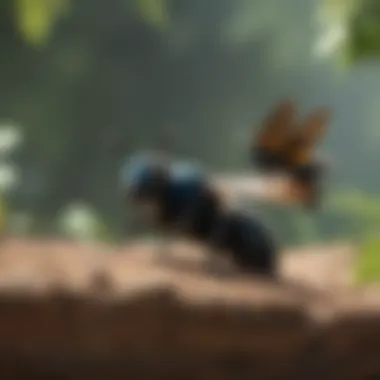Unveiling the Fascinating World of Carpenter Bees: A Detailed Exploration


Animal Species Profile
Carpenter bees are captivating insects that offer a unique insight into the intricate world of pollinators. These bees, often mistaken for bumblebees due to their similar appearance, belong to the genus Xylocopa. Their physical characteristics and appearance are notably robust, showcasing a black, shiny exoskeleton with hints of metallic blue or purple hues.
Their natural habitat and distribution cover a wide range, with a global presence on every continent except Antarctica. Carpenter bees favor nesting in wood, likening dead trees, logs, or untreated wooden structures for their shelter. Their behavior is solitary, unlike honey bees, as they create individual galleries within the wood to lay eggs and rear their young. Interestingly, they do not produce wax or honey like their more social counterparts.
Though commonly mistaken for destructive pests due to their nesting habits, carpenter bees play a vital role in pollination. As they forage for nectar and pollen, their fuzzy bodies inadvertently transfer pollen from one flower to another, aiding in plant reproduction. This behavior highlights their significance in maintaining the ecosystem's balance and supporting plant biodiversity.
Introduction to Carpenter Bees
Carpenter bees are a riveting subject of study in the entomological realm, profoundly influencing ecosystems worldwide. This article unveils the enigmatic world of carpenter bees, shedding light on their intricate nesting behaviors, pivotal role in pollination, and consequential impact on the environment. Delving into the genesis of carpenter bees within the larger context of insect ecology is critical for comprehending the intricate interplay between these unique creatures and their surroundings. Throughout this exploration, we will dissect the various aspects that make carpenter bees a fascinating subject of investigation, from their behavioral patterns to their ecological significance.
Understanding Carpenter Bees
Misunderstandings about carpenter bees often stem from their resemblance to bumblebees, leading to misconceptions regarding their behavior and impact on human habitats. In reality, carpenter bees exhibit distinct characteristics that set them apart from other bee species, especially in terms of nesting habits and foraging patterns. Understanding the biology and lifestyle of carpenter bees is paramount in appreciating their critical role in the ecosystem and dispelling prevalent myths surrounding their presence.
Importance of Carpenter Bees
The ecological importance of carpenter bees cannot be overstated, as they play a crucial role in pollination, particularly for flowering plants with tubular blossoms. Their foraging habits enhance the biodiversity of plant species and contribute significantly to the reproductive success of numerous flora. Furthermore, carpenter bees act as efficient pollinators for various crops, maintaining agricultural productivity and ecological balance. Recognizing the irreplaceable value of carpenter bees in sustaining natural ecosystems underscores the need for conservation efforts to safeguard their populations.
Common Misconceptions
One common misconception surrounding carpenter bees is their propensity to cause structural damage to wooden infrastructure. While carpenter bees may excavate nests in wood, their impact on sound structures is minimal and can be mitigated through preventive measures. Additionally, misconceptions about the aggression of male carpenter bees often lead to unfounded fears among individuals, detracting from the crucial role these insects play in maintaining environmental equilibrium. Challenging these misconceptions with accurate information is pivotal in fostering coexistence with carpenter bees in urban and rural landscapes.
Physical Characteristics
Carpenter bees possess unique physical characteristics that set them apart from other bee species. Their large size and robust build make them easily distinguishable, with most species ranging from about half an inch to an inch in length. These bees are typically plump and have a shiny black abdomen, often mistaken for bumblebees due to their similar appearance. One striking feature of carpenter bees is their smooth, hairless bodies, in contrast to the fuzzy bodies of many other bee species. This adaptation enables them to effectively navigate through narrow tunnels and burrows without accumulating dust or debris.
Carpenter bees also exhibit distinct color patterns, with some species displaying metallic blue or green hues on their bodies. These iridescent markings contribute to their aesthetic appeal and play a role in their visual communication within the colony. Another intriguing aspect of their physicality is their exceptional flying capabilities. Their translucent wings allow for efficient flight, contributing to their agility in capturing prey and pollinating plants.


In terms of physical characteristics, the carpenter bee's mandibles are crucial for various activities, including excavating wood for nest construction and gathering pollen for nourishment. These robust mouthparts enable them to bore into wood with remarkable precision, creating intricate galleries for shelter and reproduction. Understanding the physical features of carpenter bees is essential for appreciating their biology and ecological significance, underscoring the intricate adaptations that have facilitated their survival and success in diverse habitats.
Distinctive Features
Carpenter bees possess a range of distinctive features that distinguish them from other bee species. One key characteristic is their solitary nature, as these bees do not form large colonies like honey bees or bumblebees. Instead, female carpenter bees construct individual nests within wood structures, exhibiting a solitary yet meticulously organized lifestyle.
Another notable feature of carpenter bees is their buzz pollination technique. Unlike honey bees that collect pollen using their legs, carpenter bees use vibrations to release pollen from flowers, a process known as buzz pollination. This unique mechanism allows them to efficiently pollinate a variety of plant species, making them valuable pollinators in diverse ecosystems.
Additionally, carpenter bees demonstrate territorial behavior, fiercely guarding their nesting sites against potential threats. Male carpenter bees, in particular, establish territories to attract mates and defend against intruders, showcasing complex social dynamics within the species. These distinctive features shape the behavior and ecological roles of carpenter bees, highlighting their importance in ecosystem functioning and plant reproduction.
Variations in Species
Across different carpenter bee species, notable variations can be observed in terms of size, coloration, and nesting behaviors. Size discrepancies exist among species, ranging from smaller carpenter bees measuring half an inch in length to larger species exceeding an inch in size. These size variations influence their foraging patterns, nesting preferences, and overall ecological impact.
Furthermore, coloration varies significantly among carpenter bee species, with some exhibiting predominantly black coloration while others display vibrant patterns of yellow, orange, or metallic tones. These color variations serve adaptive purposes, providing camouflage in specific habitats or signaling reproductive fitness to potential mates.
Nesting behaviors also differ among carpenter bee species, with some constructing nests in dead wood while others prefer live tree branches or plant stems. Variations in nest architecture, excavation techniques, and seasonal behaviors characterize the diverse adaptations of different carpenter bee species to their respective environments. Understanding these variations in species is crucial for conservation efforts and ecological research, offering insights into the evolutionary history and biodiversity of carpenter bees.
Behavioral Patterns
In dissecting the realm of carpenter bees, it is imperative to delve into the intricate realm of behavioral patterns. Understanding the behavioral patterns of these insects is paramount in appreciating their role in the ecosystem and comprehending their interactions with other organisms. Behavioral patterns encompass a spectrum of actions, ranging from foraging habits to reproductive cycles, which collectively shape the life and impact of carpenter bees. These patterns offer insights into not only the individual behaviors of the bees but also their collective influence on their surroundings. By focusing on the behavioral patterns of carpenter bees, we can elucidate their foraging strategies, reproductive mechanisms, and their relationships with other insects in the environment.
Foraging Habits
A crucial aspect of the behavioral repertoire of carpenter bees lies in their foraging habits. The foraging habits of these insects are finely tuned to gather resources essential for their survival and reproductive success. Carpenter bees exhibit specific behaviors when searching for food sources, displaying precision and strategy in their foraging ventures. Understanding their foraging habits unveils their preferences for particular flora, their methods of pollen collection, and the impact of their foraging activities on plant life. Exploring the foraging habits of carpenter bees offers a glimpse into their foraging efficiency and the vital ecological role they play in pollination dynamics.
Reproductive Cycle
The reproductive cycle of carpenter bees is a pivotal component of their behavioral patterns, influencing their population dynamics and genetic diversity. Delving into the intricacies of their reproductive cycle unveils the stages of mate attraction, egg-laying behavior, and larval development. By unraveling the reproductive cycle of carpenter bees, one can grasp the timeline of their life stages and comprehend the factors influencing their reproductive success. Observing the reproductive cycle also sheds light on the challenges and adaptations these insects have evolved to ensure the continuation of their species amidst environmental pressures.


Interaction with Other Insects
A fascinating aspect of carpenter bee behavior is their interaction with other insects in their ecosystem. These interactions encompass a diverse array of relationships, from competitive encounters to mutualistic partnerships. Carpenter bees engage with a myriad of insect species, including pollinators, predators, and competitors, influencing the dynamics of the insect community as a whole. Exploring their interactions with other insects elucidates the interconnectedness of species within ecosystems and underscores the importance of studying these relationships for comprehending ecological systems at large. By scrutinizing their interactions, we gain a nuanced understanding of the role carpenter bees play in shaping insect communities and biodiversity.
Nesting Behaviors
When delving into the realm of carpenter bees, Nesting Behaviors emerge as a pivotal aspect that sheds light on the intricacies of these remarkable insects. The act of nesting is not merely a functional task for carpenter bees but a sophisticated behavior deeply ingrained in their survival mechanism. Understanding Nesting Behaviors provides us with crucial insights into their lifestyle, ecology, and contribution to the ecosystem.
Carpenter bees exhibit meticulous and calculated Construction of Nests, a process that involves precision and skill. Their nests are not mere shelters but architectural marvels crafted with finesse. The bees' ability to construct intricate tunnels within wood showcases their adaptability and craftsmanship. By exploring the Construction of Nests, we unravel the mastery behind carpenter bees' ability to create sustainable habitats for their offspring.
Furthermore, delving into Nest Locations unveils a lesser-known dimension of carpenter bee behavior. These insects strategically choose specific locations for their nests based on environmental cues and resource availability. Nest Locations play a crucial role in the bees' reproductive success and long-term survival. Understanding the factors that influence nest placement provides valuable insights into the adaptability and resourcefulness of carpenter bees.
Ecological Impact
Carpenter bees play a significant role in the ecosystem, specifically in pollination. Their impact on the environment is profound, contributing to the biodiversity of plant life. These bees are vital pollinators, assisting in the reproduction of various plant species. As they forage for nectar, pollen grains adhere to their fuzzy bodies, facilitating cross-pollination among flowers. This process is essential for the fertilization and production of seeds, ensuring the growth and survival of numerous plant species.
Carpenter bees' role in pollination extends beyond individual plants; it influences entire ecosystems. By pollinating a diverse range of plants, they help maintain ecological balance and support food webs. The interconnectedness of plant and animal species relies heavily on pollinators like carpenter bees to ensure the survival of flora and fauna. Understanding their ecological impact sheds light on the intricate relationships that sustain natural environments.
Exploring the conservation concerns related to carpenter bees reveals the challenges facing their populations. Habitat loss, pesticide use, and climate change threaten these crucial pollinators. It is imperative to implement conservation strategies that protect their habitats and promote biodiversity. By addressing these concerns proactively, we can safeguard the essential role of carpenter bees in pollination and ecosystem health.
Role in Pollination
Carpenter bees are proficient pollinators due to their feeding habits and body characteristics. As they collect nectar from flowers, pollen inadvertently sticks to their fuzzy bodies, enabling them to transfer pollen to other flowers as they forage. This transfer of pollen is crucial for the fertilization of plants and the production of fruits and seeds. Carpenter bees' consistent foraging behavior contributes to the sustainability of various plant species, making them valuable pollinators in diverse habitats.
Benefiting from nectar and pollen, carpenter bees support the reproductive success of flowering plants. Their efficient pollination services enhance fruit and seed production, ultimately ensuring the continuity of plant populations. By visiting numerous flowers in search of food, carpenter bees facilitate genetic diversity among plants, which is vital for their adaptation and resilience to changing environmental conditions.
Interaction with Plant Life
Carpenter bees interact closely with plant life through their foraging activities. As they visit flowers to collect nectar, these bees inadvertently transfer pollen between plants, aiding in fertilization. This interaction is crucial for the reproduction of plants, promoting genetic diversity and contributing to ecosystem stability. Carpenter bees' role in pollination influences the growth and distribution of plant species, shaping the composition of natural communities.


In addition to pollination, carpenter bees impact plant life through their nesting habits. By excavating wood to create nests, they play a role in wood degradation and nutrient cycling in forest ecosystems. These interactions highlight the interconnectedness between carpenter bees and plant life, showcasing the intricate relationships that govern ecological processes.
Conservation Concerns
Conservation efforts are imperative to protect carpenter bee populations and ensure their continued role in pollination. Habitat destruction, pesticide exposure, and climate change pose significant threats to these important pollinators. Conservation initiatives should focus on preserving diverse habitats, reducing pesticide use, and advocating for climate change mitigation to safeguard carpenter bees and the plant species they support.
Addressing conservation concerns requires collaborative efforts from researchers, policymakers, and the general public. By raising awareness about the importance of carpenter bees in ecosystem health and promoting sustainable practices, we can mitigate the challenges they face. Conservation actions play a crucial role in preserving biodiversity and enhancing the resilience of pollinator populations for future generations.
Human-Carpenter Bee Encounters
In this section dedicated to Human-Carpenter Bee Encounters, we delve into the interactions between these fascinating insects and humans. Understanding the impact of such encounters is crucial in appreciating the coexistence between humans and carpenter bees. These encounters hold significance in shedding light on how human activities can affect carpenter bee populations and behaviors. By exploring these interactions, we can gain insight into the potential benefits and challenges that come with sharing spaces with these pollinators.
Preventive Measures
When considering preventive measures in dealing with Human-Carpenter Bee Encounters, adopting proactive practices is essential. Implementing strategies to minimize potential conflicts and disturbances between humans and carpenter bees is key. Simple actions such as maintaining a clean and organized outdoor space can deter carpenter bees from nesting in unwanted areas. Educating individuals about the importance of carpenter bees and their role in the ecosystem can also lead to more peaceful cohabitation between humans and these insect species.
Addressing Infestations
Addressing infestations resulting from Human-Carpenter Bee Encounters requires a strategic approach. Recognizing early signs of bee activity around structures is crucial in addressing infestations promptly. Seeking assistance from pest control professionals with expertise in handling carpenter bee infestations can ensure effective removal while prioritizing the well-being of the bees. Implementing environmentally-friendly practices during extermination processes can help in preserving the delicate balance of the ecosystem while addressing infestation concerns.
Future Research and Conservation Efforts
In the realm of carpenter bees, the avenue of future research and conservation efforts plays a critical role in ensuring the sustainability of this insect species. By delving into this facet, we can unearth a plethora of opportunities for enhancing our understanding and coexistence with these essential pollinators. Research endeavors could focus on exploring the intricate dynamics of carpenter bee behavior in response to environmental changes, shedding light on how these insects adapt and contribute to ecological balance. Furthermore, investigating the genetic diversity among carpenter bee populations can offer valuable insights into their evolutionary mechanisms and resilience against habitat loss.
Conservation efforts aimed at preserving carpenter bee habitats are paramount for safeguarding their population and biodiversity. Initiatives such as habitat restoration projects and creation of pollinator-friendly zones can significantly benefit carpenter bees and other wildlife dependent on them. Collaboration between researchers, conservationists, and policymakers is instrumental in formulating comprehensive strategies to address the challenges faced by carpenter bee populations. By integrating sustainable practices into conservation initiatives, we can strive towards a harmonious coexistence with these fascinating insects.
Areas for Further Study
Exploration into areas for further study in the realm of carpenter bees opens a realm of possibilities for expanding our knowledge and devising robust conservation strategies. In this context, researching the impacts of environmental pollutants on carpenter bee health and behavior emerges as a crucial area that demands attention. Understanding how factors like pesticides and pollutants influence carpenter bee populations can guide the implementation of policies to mitigate adverse effects and promote healthier ecosystems.
Additionally, delving into the foraging preferences of different carpenter bee species can offer valuable insights into their dietary habits and plant interactions. By unraveling the intricate relationships between carpenter bees and floral resources, researchers can enhance our understanding of pollination networks and biodiversity conservation. Explorations into the nesting preferences and materials used by carpenter bees can also provide valuable information for habitat restoration initiatives and sustainable urban planning.
Sustainable Practices
The adoption of sustainable practices stands as a cornerstone in promoting the conservation of carpenter bees and their habitats. Implementing integrated pest management techniques that prioritize non-invasive methods can help reduce human-wildlife conflicts and safeguard carpenter bee populations. Furthermore, promoting the cultivation of native flowering plants and establishing green spaces can create favorable environments for carpenter bees to thrive and fulfill their essential roles in pollination.
Educational programs aimed at raising awareness about the importance of carpenter bees in ecosystems can mobilize community support for conservation initiatives. By fostering a deeper appreciation for these remarkable insects, we can inspire collective action towards ensuring their survival for future generations. Embracing sustainable beekeeping practices that prioritize the well-being of carpenter bees and minimize disturbances to their natural habitats is crucial for fostering a harmonious relationship between humans and these vital pollinators.







